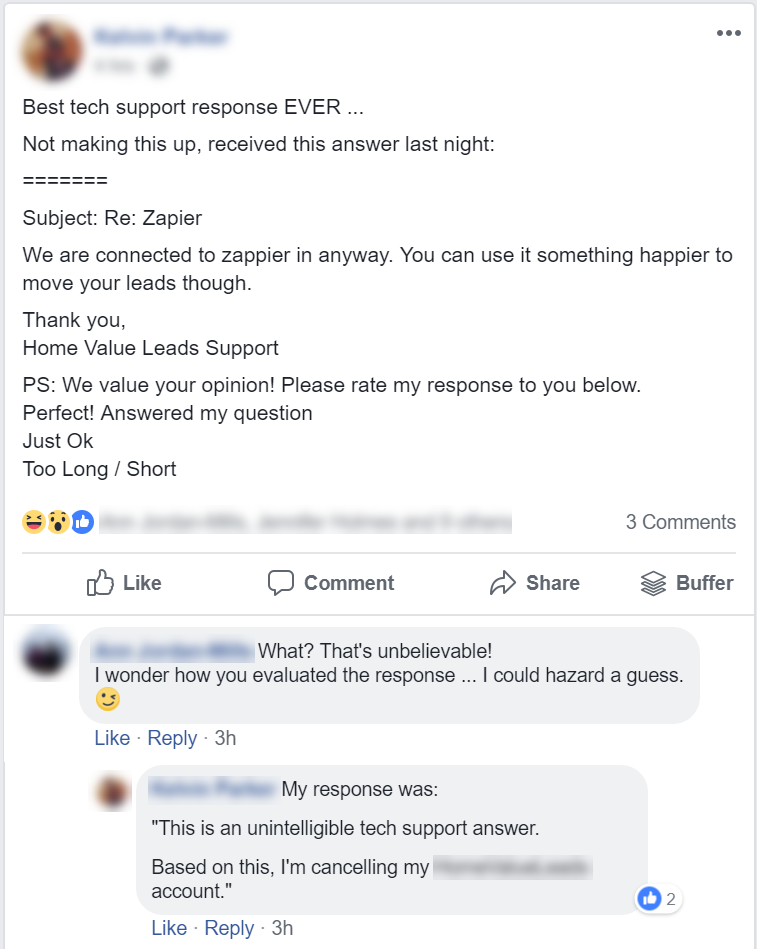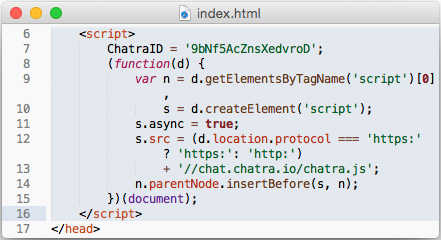of Remarkable
Customer
Support
Communicate Clearly
& Compassionately
Agents aren’t usually hired for their writing skills. We get that. Yet today, when support is provided largely through emails and live chat, writing skills are far more important than most people realize.

“People don’t want to communicate with an organization or a computer. They want to talk to a real, live, responsive, responsible person who will listen and help them get
satisfaction.”
Now, before we go any further, understand that we aren’t asking agents to get a degree in writing. We aren’t even expecting messages to be one hundred percent grammatically correct. But we are raising the bar on written communications. To offer remarkable service, your messages must be written both clearly and compassionately.
In case you have any doubts, look at this example, which showed up in our Facebook stream as we were writing this chapter. It makes our point perfectly:

A marketing consultant’s example of what not to do
The man who shared this email is not your ordinary consumer. He’s a professional copywriter and marketing consultant — as are most of his connections in social media. His post is meant as a cautionary tale, a lesson in what not to do. Even more important, notice his reaction after receiving this message:
“ I’m cancelling my…account”
Do all people have such a strong reaction to a message that’s badly written? In most cases, yes. And we believe their reaction stems from two expectations they bring to every interaction with a company.
The first is knowledgeability. In a study on the “State of Customer Experience”, researchers found that consumers' number-two expectation of companies is a knowledgeable agent. A similar study by Northridge Group reported that the number-one complaint against customer service agents is that they aren’t knowledgeable enough. Clearly, consumers want to be sure the answers they’re given are accurate. That hope is dashed when an agent sends them a message that’s incoherent.
Genesys: State of Customer Experience research
The Northridge Group: State of Customer Service Experience 2017
The second expectation is a quick solution. Messages that are poorly written take more time than necessary to decipher. And if it can’t be unraveled, the customer has to re-engage with the agent to clarify the meaning — which means they’re putting even more time into an interaction they already don’t trust.
Bottom line, once customers decide the agent they’re working isn’t knowledgeable, they lose trust in anything else the agent may say. That’s why customers will leave a company after getting a message that’s hard to understand. It’s not that they expect professional writing; they’re looking for a company they can trust.
We like the way Andre Schwager and Chris Meyer express this in an article they published in the “Harvard Business Review”:
“ Consumers have a greater number of choices today than ever before, more complex choices, solutions to problems — not fragmented, burdensome ones — will win the allegiance of the time-pressedconsumer.”
Andre Schwager and Chris Meyer, Harvard Business Review: Understanding Customer Experience
Bad writing is burdensome. It wastes the reader’s time and forces them to puzzle out the meaning — when a well-written message would have taken only seconds.
Successful customer support depends on you to give them quick, effective solutions. That’s why we consider clear, compassionate communication the third element of unforgettable customer service. Fortunately, it’s much easier than you think to ensure your messages are understandable.
Tips for Communicating More Clearly
If you remember, consumers want effective, workable solutions, and they don’t want to work hard for them. To give your customers what they want, you need to make sure your messages say what you mean and are easy to understand. Here are some tips for making your side of the conversation a hundred percent clearer.
Get to the Point
When emailing or messaging friends, we’re in the habit of leading with social niceties. With customers, this approach can be distracting — especially when all they want is a quick answer.
Not to diminish the social graces; speed is a much higher priority for people reaching out to customer support. The Aspect Consumer Experience Index found that people value accuracy, effectiveness, and speed more than anything else, and the inability to meet these three criteria is the top source of consumer frustration.
Don’t be afraid to get right to the point. You may start your conversation with a greeting, but you should keep it short.
In chat, you can say something like:
“Are you finding what you need? Let me know if you need help,”
or you can simply introduce yourself and answer the question your customer has asked.
Your goal is to be quick and efficient. This communicates that you’re there for your customers, eager to answer their questions. As a bonus, you’ll also come off as more professional and knowledgeable.
Don’t Leave Gaps
Remember, customers want accurate information they can trust. They want to feel confident that they’re getting accurate, complete information — not a scripted answer or a quick band-aid that covers up their problem rather than solving it. Ultimately, they want to feel you understand the question, have a real answer, and can customize it to their situation.
So how do you do that?
First, know your stuff. You need adequate training to be able to talk intelligently about your product, its features, and the problems that might arise. You also need to be fluent in whatever language you’re using to support your customers.
Second, you need to be able to apply that knowledge to whatever problem your customers bring up, and find work-arounds where needed. You can only do that if you know your stuff… and know it well.
Finally, you need to be able to express those solutions in writing — simply and without leaving any gaps or confusing your customer.
Look again at the Facebook post we shared in the introduction to this chapter. The gaps in that support email weren’t informational. They were linguistic in nature. The answer was gibberish, probably because the company had hired overseas help to manage customer support. Answers were either copied and pasted or run through a translation app. Either way, they don’t measure up to the minimum standards of remarkable customer support.
In most cases, you’ll be focused on avoiding informational gaps — leaving out basic information that you assume people already know. The trouble is, “assumed knowledge” is usually reserved for industry insiders. So before hitting the Send button when answering questions, review your answer to see if you accidentally left out any basic information that might be helpful. Then, fill in the gaps.
Keep It Simple
While you do want to come off as knowing your stuff, you don’t want to use a lot of industry terms, jargon, big words, or slang.
Big words and jargon don’t impress anyone. Your knowledge should be like a Wiki site: there if you need it, invisible if you don’t. If you can talk naturally about your topic, breaking down complex information into easy-to-digest, bite-sized pieces of information, it’s clear you know the topic inside and out. There’s no need to show off.
Slang and texting terms are also a no-no. While you want to be human and relatable, you shouldn’t use slang or emojis to achieve that goal. Terms that are unfamiliar to your customer can quickly become burdensome, forcing them to think too hard or outright confusing them. So avoid terms that may not be easily understood by everyone. BTW (by the way) and TTYL (talk to you later) are examples of texting terms you should avoid.
Make It Easy to See Options and Respond
Sometimes you’ll need to provide long, complex answers. In chat, it can be easier to provide the information one sentence at a time. But in email support, you need to focus on presentation. Otherwise, you could inadvertently bury important information.
Here are three tips for making it easy for your customers to get the point in email support messages.
- Use shorter paragraphs and sentences. One-sentence paragraphs are fine, especially if the information is important. As a one-liner, it’s sure to be seen.
- Whenever you’re listing items, use bullets. If you try to list a series of items within a paragraph, separated only by commas, they won’t stand out.
- If you’re listing options and asking your customer to choose, treat the options like a fast-food menu. Number each of them, so your customer can easily tell you their choice. (“I like number two,” for instance.)
In all your communications, your goal is to keep things as simple and understandable as possible. It may require you to break some of the rules you learned in a composition class, but when it comes to supporting your customers, clarity wins the day.
Never Make Assumptions
Your customers likely come from all over the world, from all socioeconomic levels, and have a wide range of communication styles. Count on it: there will be countless cases where judgment or confusion slip into the conversation.
Perhaps a customer’s question doesn’t make sense, or you need information from them and can’t get them to understand what you need. Alternatively, the customer could say something that triggers an unconscious prejudice in you. At all costs, you must avoid making assumptions or judgements that could affect the quality of your support.
When confusion enters the mix, don’t let yourself get impatient. When you or your customer is confused or one of you doesn’t understand a question, slow down. Ask for more information. Find another way to express yourself.
If you find yourself guessing the meaning of your customer’s request, don’t make assumptions. Make sure you understand what your customer needs before continuing the conversation.
If you feel yourself making assumptions about a customer’s intelligence, background knowledge, or communication style, monitor yourself carefully to avoid making a rude comment or adopting an offensive tone.
You’ve probably experienced a rude or impatient support agent at least once. We all have. I, Kathryn, once called customer support to diagnose a problem with a printer. The agent began the call by asking for the information she needed to help me, including the type of printer and my computer set-up.
Understand, I’m more technically adept than average, but even so, there were a few questions about my hardware that I couldn’t answer off the top of my head. Immediately, I could hear the shift in the agent’s tone towards me. For the rest of the call, she spoke as if I wouldn’t be able to find the on/off button on my computer. I even addressed her assumption, and she ignored me, continuing the demeaning attitude throughout our entire call.
This type of prejudice is toxic to a customer’s experience. The only assumption you should make is that your customer is intelligent but busy. And when in doubt, assume you’re wrong, and not your customer.
Use Screenshots and Video Captures
Sometimes, words alone make a simple procedure sound confusing or overly technical. A picture or video, on the other hand, can make things crystal clear. For these cases, it helps to have a library of quick screenshots or video captures that answer the most common challenges your customers face.
The key is to keep things simple. In many cases, your video capture may not even need words. It simply needs to walk the customer through the process.
For instance, here at Chatra, we know that many of our customers will struggle to put the widget code for our software on their website. We provide written instructions, but to make sure they’re understandable, we include this screenshot as well:

Proofread!
Before sending any message, review it to be sure it makes sense, is grammatically correct, and has no glaring typos. No one expects perfection, but your communications need to be clear.
This is especially important if you’re copy-pasting answers. Without reviewing them, you could miss notes that were meant for you (the agent) and not for your customers.
The last thing you want to send is something that looks like this:
Hi Justin,
Thank you for contacting us about XXXfragranceXXX. At this time, this fragrance is not available. We understand your disappointment in discovering that your favorite scent will no longer be a prat of our product line.
Justin, many products are seasonal and only sold during specific times of the year. Other products and fragrances are retired for various reasons. We continually evaluate current and future trends, as well as customer responses and reaction. Customer feedback regarding our products and services is always welcomed and appreciated.
We would be happy to forward your request for this scent to return. Additionally, we would be happy to provide an alternative that you may enjoy as well.
Since you loved XXX, I would recommend XXX CHOOSE ALTERNATIVE FRAGRANCE XXX. You’re sure to love it! I have inserted a link below for you to take a look on our website.
XXXinsert link here and connectionXXX
We appreciate you shopping with us, Justin!
Thanks,
Megan
Whether you use pre-written snippets of information to support your customers or write unique responses to every customer, take time to proofread your responses before sending them.
Tips for More Empathetic Communications
Communication is both technical and relational. We’ve just reviewed tips for getting your words right on a technical level. Now let’s look at two ways to make sure your words are equally compassionate.
Deliver Trust
Andrew Newberg and Mark Waldman, in their book “Words Can Change Your Brain”, create a compelling case for adapting your communication strategies to build trust and resolve conflict. In fact, they’ve discovered that their twelve-step approach to compassionate communication can actually rewire your brain to become more empathetic. Sounds perfect for customer support.
Their process starts before you connect with a customer — putting yourself in a frame of mind that lets you achieve an “inner state of intense awareness and calm:”
- Relax.
- Stay present.
- Cultivate inner silence.
- Increase positivity.
- Reflect on your deepest values.
- Access a pleasant memory.
Once you’ve completed these steps, you’re able to engage effectively, according to the authors. Then, you’re ready for the next step:
- Observe nonverbal clues.
By nonverbal clues, they mean micro-messages, which tell you what the other person is thinking and feeling. These clues give you the background information you need to have an effective conversation. And once you’ve taken them in, you’re ready to start the conversation:
- Express appreciation.
- Speak warmly.
- Speak slowly.
- Speak briefly.
- Listen deeply.
The idea is to remain fully present during a conversation, so you’re able to create the cognitive and emotional connection required for empathy. By relaxing and staying positive, you’re able to avoid behaviors that could make your customer angry. You may also be able to defuse volatile situations more quickly. By observing the micro-messages available to you, whether you’re communicating over the phone or in written formats, you’re in a better position to make your customer feel important.
Of course, the most important of the twelve rules are the last five. They directly impact your customers and are designed to improve comprehension, empathy, and trust. But notice how simple they all are. The truth is, clear communication is simple. It’s all about remembering the basics.
Break the Blaming Habit
In customer support, you hear complaints and problems all day long, and in most cases, customers are looking for someone to blame. Don’t get defensive. Understand that your customers may feel like they’re in over their heads. They may also need to remove blame from themselves. But blaming doesn’t solve anyone’s problems, so don’t join them in the blame game.
Take a deep breath and take a mental step back. Remind yourself it isn’t your fault — and may not be anyone’s fault. Sometimes, things simply go wrong.
Focus on understanding what the problem is, what your customers need, and how you can give them a helpful solution. No blaming is necessary. Don’t try to make it someone else’s problem. Accept responsibility where you should. Apologize where it’s needed. And work towards a win-win situation.
Joel Spolsky, a software developer in New York City, tells the story of his experience with a locksmith who, try as he might, couldn’t make a copy of Joel’s apartment key that worked. Joel knew the risk and went back home to test the new key. Not once, but twice, the key didn’t work. On this third visit to the locksmith, Joel says he had squiggly lines coming out of his head. He was fuming. But the locksmith looked at the key and calmly said:
“It’s my fault.”
Joel Spolsky: Seven steps to remarkable customer service
That was it. Joel’s rage dissipated, and all was well. “It’s my fault,” is just one phrase you need to have ready at all times. Others include:
“I can’t accept your money.”
“I’m sorry. Tell me what happened so I know what we need to do to fix it.”
Or simply:
“How can I make it better?”
Clear communication is the foundation of remarkable customer support. But it involves more than getting your word choice right or nailing your grammar and spelling. Effective communication relies on the technical and emotional aspects of the conversation. Both.
Of course, there are some nuances, many of which come easier if you’ve got naturally high emotional intelligence. Things like realizing it isn’t always productive to give a response; simply listening may be enough. Or understanding that different personalities want to be helped in different ways; some want more emotional engagement while others want things handled in a strictly matter-of-fact way.
One final nuance merits special attention: tone of voice. We’ll give it a closer look in the next chapter.
with Empathy
of Tone